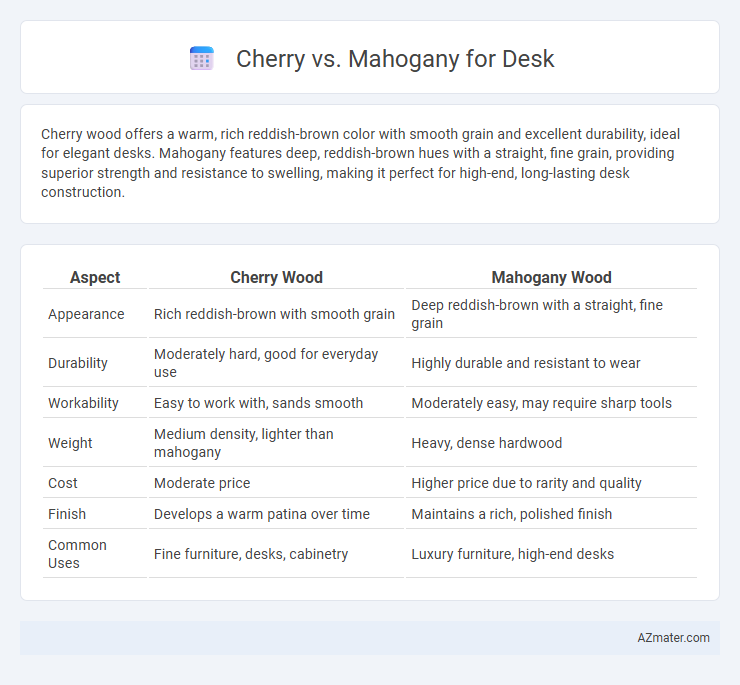Cherry wood offers a warm, rich reddish-brown color with smooth grain and excellent durability, ideal for elegant desks. Mahogany features deep, reddish-brown hues with a straight, fine grain, providing superior strength and resistance to swelling, making it perfect for high-end, long-lasting desk construction.
Table of Comparison
| Aspect | Cherry Wood | Mahogany Wood |
|---|---|---|
| Appearance | Rich reddish-brown with smooth grain | Deep reddish-brown with a straight, fine grain |
| Durability | Moderately hard, good for everyday use | Highly durable and resistant to wear |
| Workability | Easy to work with, sands smooth | Moderately easy, may require sharp tools |
| Weight | Medium density, lighter than mahogany | Heavy, dense hardwood |
| Cost | Moderate price | Higher price due to rarity and quality |
| Finish | Develops a warm patina over time | Maintains a rich, polished finish |
| Common Uses | Fine furniture, desks, cabinetry | Luxury furniture, high-end desks |
Introduction to Cherry and Mahogany Desks
Cherry desks showcase a rich, reddish-brown hue that deepens with age, prized for their fine grain and durability, making them a timeless choice in traditional and modern office designs. Mahogany desks feature a deep, reddish-brown color with a straight, fine grain, known for exceptional strength and resistance to wear, often used in high-end, classic furniture pieces. Both woods offer distinct aesthetic appeal and longevity, with cherry providing a warm, inviting tone and mahogany delivering a bold, elegant presence.
Wood Grain and Appearance Comparison
Cherry wood features a fine, straight grain with a smooth texture that deepens to a rich reddish-brown over time, enhancing the desk's elegance and warmth. Mahogany showcases a more pronounced, interlocking grain pattern with a deeper, reddish-brown hue that often includes subtle streaks, lending a classic and luxurious appearance to furniture. Both wood types offer durability and a polished finish, but cherry is favored for its evolving patina while mahogany is prized for its consistent richness and striking grain complexity.
Durability and Strength Differences
Cherry wood offers moderate durability with a fine, smooth grain that resists warping, making it ideal for desks that require both aesthetic appeal and resilience. Mahogany, known for its exceptional strength and hardness, provides superior resistance to dents and scratches, ensuring long-lasting performance in high-use environments. Although mahogany is generally harder than cherry, both woods are stable and durable, but mahogany's denser fibers deliver enhanced structural integrity for heavy-duty desk applications.
Color and Aging Characteristics
Cherry wood features a warm reddish-brown hue that deepens and develops a rich patina over time, enhancing the desk's character and elegance. In contrast, mahogany showcases a deeper, reddish-brown color with a consistent tone that ages gracefully, often darkening slightly but maintaining a smooth, polished appearance. Both woods offer excellent durability, but cherry's color transformation is more pronounced, making it ideal for those who appreciate visible aging in their furniture.
Workability and Craftsmanship
Cherry wood offers exceptional workability due to its fine, straight grain and smooth texture, making it ideal for intricate detailing and fine craftsmanship in desk construction. Mahogany, known for its durability and rich, reddish-brown color, carves easily while maintaining a smooth finish, lending itself well to both traditional and modern desk designs. Craftsmanship with cherry wood results in elegant, warm-toned pieces that age beautifully, whereas mahogany provides a robust, timeless look with excellent resistance to wear and tear.
Cost and Availability Analysis
Cherry wood desks typically cost between $800 and $1,500, reflecting their moderate availability and regional growth primarily in the eastern United States. Mahogany desks, often priced from $1,200 to $2,500, are less abundant due to restricted harvesting regulations in tropical regions, making them a rarer and more expensive option. Both woods offer durable furniture solutions, but cherry ranks higher in affordability and widespread availability compared to the premium and limited-source mahogany.
Environmental Impact and Sustainability
Cherry wood, sourced primarily from sustainable forests in the eastern United States, offers moderate environmental impact due to its faster growth rate compared to mahogany, allowing for more efficient reforestation. Mahogany, often harvested from tropical rainforests, presents significant environmental concerns including deforestation and habitat loss, though certified options like FSC mahogany promote responsible forestry. Choosing cherry over mahogany for desks supports lower carbon footprints and easier supply chain transparency, contributing to more sustainable furniture production.
Maintenance and Care Requirements
Cherry wood desks require regular dusting and occasional polishing with a quality wood conditioner to maintain their rich, reddish-brown finish and prevent drying or cracking. Mahogany desks benefit from periodic cleaning with mild soap and water, followed by a protective wax or oil application to preserve their deep, warm tones and resist moisture damage. Both woods should be kept away from direct sunlight and extreme humidity to avoid warping and fading.
Best Uses: Home Office vs. Professional Setting
Cherry wood's rich reddish tones and smooth grain make it ideal for home office desks, providing a warm and inviting atmosphere that enhances productivity and comfort. Mahogany's dense, durable nature and deep, dark hues suit professional settings, offering a prestigious and timeless appearance that withstands heavy use. Both woods are excellent choices, but cherry fits home office aesthetics while mahogany excels in formal, high-traffic environments.
Final Verdict: Choosing the Right Wood for Your Desk
Cherry wood offers a warm, reddish hue with smooth grain that deepens beautifully over time, making it ideal for desks with classic elegance. Mahogany features a rich, darker tone and exceptional durability, providing a robust surface resistant to scratches and dents, perfect for high-traffic workspaces. Selecting between cherry and mahogany depends on your preference for color evolution and usage demands, with cherry enhancing aesthetic appeal and mahogany maximizing long-term strength.

Infographic: Cherry vs Mahogany for Desk
 azmater.com
azmater.com